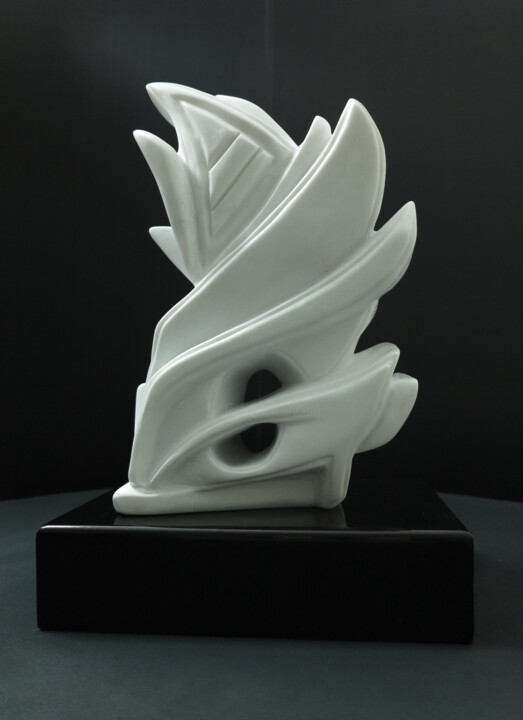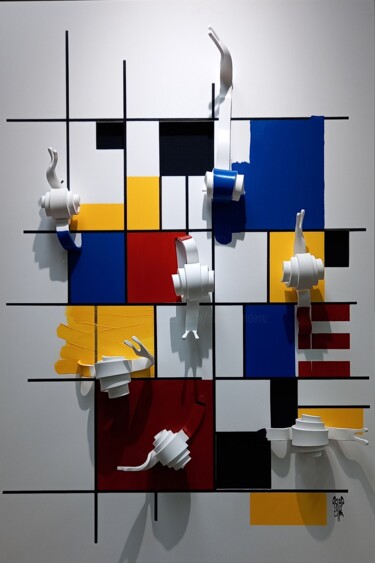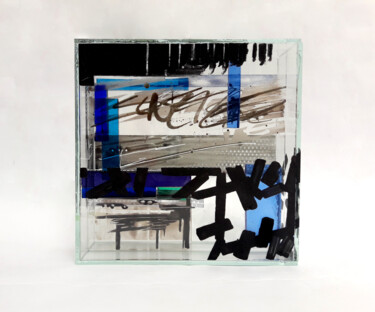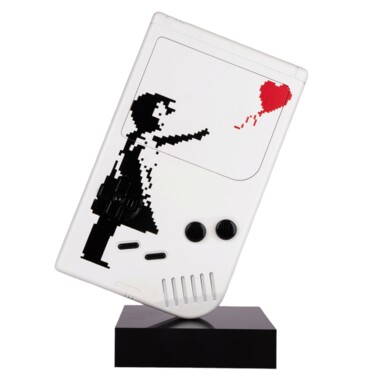189 Esculturas contemporáneas originales para la venta:
¿Cómo definir estilo Arte en la calle ?
Street Art is visual art produced in public spaces for viewing by the general public and is intended to spread a social and political statement. It has been referred to as "guerrilla art," "post-graffiti," "neo-graffiti," and "independent art." Street art is seen as the zenith of democratic art because it can be viewed by anybody and is not owned. Artists have introduced this unusual and democratic work into institutions and galleries throughout the past few decades, garnering recognition on a global scale and popularity in the "traditional" art world. The city and its residents have an impact on street artists' environment and sources of inspiration. Their main themes frequently examine ideas of popular culture, ads, cartoons, and urban settings. Street art is full of inventiveness and constantly looking for new techniques, supports, and materials, from the abstract to the figurative.
The fundamental idea behind street art is that everyone should have the opportunity to create art and have it seen by others, regardless of their race, age, gender, economic status, or other characteristics. It also believes that art should be accessible rather than hidden away inside galleries, museums, and private collections. Even though some street artists may make sculptures or installations, they are more well recognized for using uncommon art materials like wheat paste, spray paint, stencils, and stickers.
The most well-known artists of today developed their reputations on the streets. Graffiti artists like Keith Haring and Jean-Michel Basquiat, whose works were found on public walls as well as in galleries and museums, had a big impact on later generations of artists, particularly Banksy and Fairey. Street art has historically had a tense relationship with the art world as a whole due to its roots in illegal activity and distinctive interest in subversion, political, and social action.
Street Art sculpture
In sculpture, Street Art is a movement and a form of artistic expression characteristic of the late twentieth century, early twenty-first. Many sculptors have marked the history of this movement through his handling of volumes: this is particularly the case of Mark Jenkins and his hooded figures, but also of Isaac Cordal and his miniatures characters very critical of our social development, or the Gregos parisian with his persons making faces. Around the world, Street art sculpture continues to be a popular category of art and many of its creators have achieved renown and mainstream success.
Street Art Sculptors
Mark Jenkins (born 1970)
American artist Mark Jenkins creates sculptural street installations. Jenkins uses the "street as a theater" in his street art, allowing his sculptures to interact with the environment. With his hyperrealistic sculptures that he places in the streets across Europe and the United States, Mark Jenkins explores how people see the world. The staging is often uncomfortable and the faces of the people are frequently obscured. Since he wraps live figures in plastic films and tape, his technique is likewise hidden. The "cast" is then cut out, put back together without the figure, dressed, and given realistic features like hands and hair.
Gregos (born 1972)
French street artist Gregos began displaying his face on the buildings in Paris. He creates a reproduction of his face with his tongue out or smiling that he paints and adheres to the walls of Paris using his own 3D concept, which he designed utilizing all the techniques he had learned and refined over the years. Each face serves as a kind of self-portrait for the day, expressing the humor of the wearer and his past, present, and future.
The street art concept by Gregos is effective at encouraging conversation between the faces and among spectators. More than 500 faces have been installed so far, largely in Paris but also in other French cities and cities across the globe, including Europe, the United States, Japan, and South America.
Isaac Cordal (born 1974)
Isaac Cordal is a Spanish Galician artist who specializes in miniature art. His creations feature miniature animals built of cement, which is often thought of as the mark of civilization, and are positioned in unexpected places like gutters and puddles. Due to its small size (about 15 cm), finding them requires careful attention. They are frequently depicted in ordinary activities, and the setting choice can introduce new dimensions to the action. They typically highlight how ludicrous our current world is. The artist uses the sculptures as a metaphor to analyze politics, bureaucracy, and power.
Christiaan Nagel (born 1982)
Christiaan Nagel is a British street artist known for his oversized mushroom sculptures made from polyurethane which he places high up on buildings. They reach as far as Los Angeles, Cape Town, Berlin, Barcelona, London, New York, and Cape Town. These polyurethane mushrooms come in various sizes and individual samples or flocks. The artist claims that although mushrooms naturally develop, they require ideal weather and environmental circumstances, such as original artistic and scientific concepts.
Descubre esculturas contemporáneas de arte callejero en Artmajeur
Las Esculturas de Arte Urbano Contemporáneo son un tipo de obra de arte original que ha ganado inmensa popularidad en los últimos años. Los principales tipos de soportes utilizados para estas esculturas son paredes, edificios y espacios públicos. Los materiales utilizados incluyen pintura en aerosol, plantillas, madera, metal y plástico, entre otros. Lo que hace que este tipo de obra de arte sea único es su capacidad para llevar el arte a las calles y hacerlo accesible para todos.

©2023 2mé / Blondeau
Orígenes e Historia
El movimiento del graffiti, que comenzó en la década de 1970, fue una respuesta significativa a la falta de representación de las comunidades marginadas en el mundo del arte. Los artistas del graffiti utilizaron espacios públicos para expresarse y transmitir sus mensajes. Este movimiento llevó a la aparición del arte callejero en la década de 1980. Los artistas callejeros comenzaron a crear no solo graffitis, sino también murales, pegatinas, carteles y esculturas utilizando materiales como metal, madera y concreto. Las esculturas contemporáneas de arte callejero continúan evolucionando, con nuevos artistas y estilos emergiendo todo el tiempo.

©2023 Sand
Evoluciones de estas Obras en el mercado de arte contemporáneo
Las esculturas de arte callejero contemporáneo han experimentado una evolución significativa en los últimos años. El movimiento, antes underground, ha ganado reconocimiento en el mainstream, con artistas explorando nuevos materiales y técnicas para crear obras impactantes. Esto ha resultado en un aumento del interés en el mercado de arte contemporáneo, con coleccionistas e inversores buscando estas piezas únicas y provocadoras. La importancia de estas esculturas radica en su capacidad para desafiar las nociones tradicionales del arte, creando un diálogo entre el artista y el espectador. Además, su ubicación en espacios públicos significa que tienen el poder de transformar el paisaje urbano, haciendo el arte más accesible e inclusivo. A medida que el movimiento de esculturas de arte callejero continúa evolucionando, será fascinante ver cómo los artistas navegan la tensión entre el éxito comercial y la integridad artística.

©2023 Shelby Artista representado por Studio Tangerine
Artistas Famosos Relacionados
Los Artistas Contemporáneos que se especializan en esculturas de arte callejero son muy solicitados por sus enfoques únicos e innovadores hacia esta popular forma de arte. Estos artistas utilizan una variedad de técnicas y materiales para crear impresionantes esculturas que capturan la esencia de la vida urbana.
Uno de estos artistas es un escultor conocido por su trabajo intrincado y altamente detallado. Es muy habilidoso trabajando con metal, y sus esculturas a menudo incorporan objetos encontrados y otros materiales para crear un efecto visual impactante. Otro artista es conocido por sus esculturas audaces y coloridas que incorporan elementos de graffiti y arte callejero. Su trabajo es altamente reconocible y ha ganado una gran cantidad de seguidores entre los entusiastas del arte callejero.
Otro artista es conocido por sus instalaciones a gran escala que transforman los entornos urbanos en obras de arte. Sus esculturas a menudo incorporan elementos de la arquitectura y el paisaje circundante, creando una integración perfecta entre el arte y el entorno construido. Otro artista es conocido por su uso de materiales no convencionales, como plásticos reciclados y otros materiales de desecho, para crear esculturas caprichosas y provocativas que comentan sobre temas de sostenibilidad y medio ambiente.
En general, estos artistas contemporáneos son altamente habilidosos en su arte y aportan una perspectiva única a las esculturas de arte callejero. Ya sea trabajando con metal, graffiti o materiales no convencionales, están empujando los límites de lo que es posible en esta forma de arte emocionante y dinámica.Notables esculturas de arte urbano contemporáneo
Las esculturas contemporáneas de arte urbano se han convertido en una forma significativa de arte urbano, capturando la atención del público en todo el mundo. Aquí están algunas de las esculturas de arte callejero más renombradas y sus descripciones:
The Fearless Girl - Kristen Visbal - 2017 La Niña Valiente es una escultura de bronce de una joven parada confiadamente con las manos en las caderas, mirando fijamente al famoso Toro de Wall Street. La escultura fue creada por Kristen Visbal e instalada en 2017 como un símbolo de empoderamiento femenino y diversidad de género en Wall Street.
Balancing Act - Roa - 2018 El artista belga Roa creó Balancing Act, una escultura de un roedor gigante equilibrándose en su cola, en 2018 en Melbourne, Australia. La obra de arte fue inspirada por la próspera población de ratas de la ciudad y su capacidad de adaptación al entorno urbano.
Love Me - Curtis Kulig - 2011 Love Me es una escultura de las palabras "Love Me" escritas en letras brillantes y audaces. Creada por el artista Curtis Kulig en 2011, la escultura ha sido instalada en ciudades de todo el mundo, incluyendo Nueva York, París y Tokio. La obra de arte es un mensaje de amor y positividad al público.
KAWS: Holiday - KAWS - 2019 KAWS: Holiday es una serie de cinco enormes esculturas creadas por el artista estadounidense KAWS en 2019. Las esculturas representan a su icónico personaje Companion reclinado en varios lugares alrededor del mundo, como Hong Kong, Japón y Estados Unidos. La obra de arte es una visión lúdica y caprichosa sobre los viajes y la aventura.
The Knotted Gun - Carl Fredrik Reuterswärd - 1980 The Knotted Gun, también conocido como No Violencia, es una escultura de bronce de un revólver con su cañón atado en un nudo. Creada por el artista sueco Carl Fredrik Reuterswärd en 1980, la obra de arte se ha convertido en un símbolo de paz y no violencia en todo el mundo, y se encuentra instalada en varios lugares, incluyendo la sede de las Naciones Unidas en Nueva York.

Cyborg Corrigé
Escultura - artwork_cat. | 63x35x30 cm

Eric Vialla (Tweak)
Escultura - Metales | 38x130x44 cm

Jordan Jeffray
Escultura - Acrílico | 95x28x22 cm

Carole Carpier
Escultura - Resina | 21,5x6x8,5 cm
































